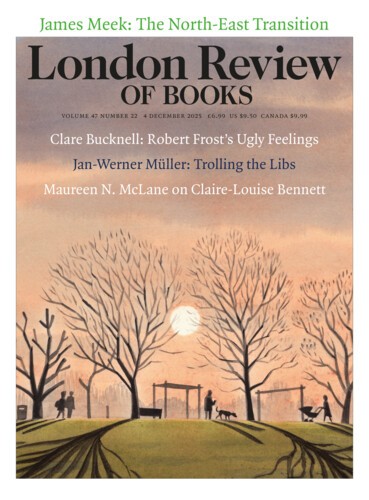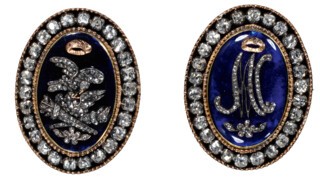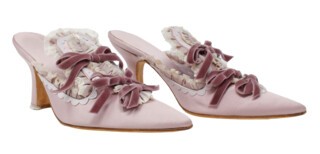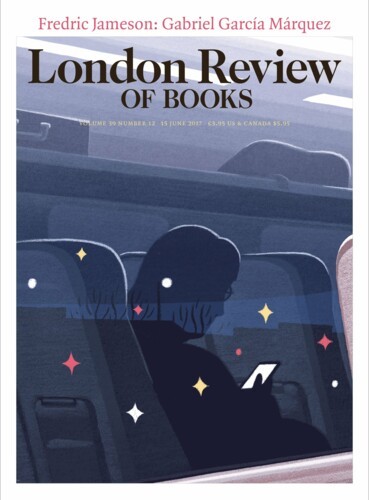She is the queen of excess, who teaches us the lessons of history with shepherdess costumes and lace ruffles. Marie-Antoinette, consort to Louis XVI of France, frolicked her way to revolution and death by guillotine. Her blithe irresponsibility is on display at the V&A (until 22 March) and in the accompanying catalogue, which captures the show’s aesthetic appeal.
The exhibition delights. So many pastel skirt billows contrasting with tightly laced bodies. Such big hair and such tiny mules! Turning a conservation requirement for low lighting into dark drama, the curator, Sarah Grant, has created a tableau of gleaming clothing, sparkling jewellery, paintings and prints. Almost no all-white muslin gowns survive from the late 18th century, though they have been immortalised in countless portraits. Grant has obtained the loan of one, from the Musée de la toile de Jouy. Meticulous research hides behind some seemingly obvious juxtapositions, such as a real striped jacket and its exact double worn by Marie-Antoinette in a portrait of 1788 by Adolf Ulrik Wertmüller. Little remains of Marie-Antoinette’s actual clothing: a shoe, a chemise, a skirt fragment.
Mirrored cases alternate with entrancing kaleidoscopic videos. One minute, the exhibition stages front and rear views of rare treasures, such as the vast-skirted silver brocade wedding gown worn by Hedvig Elisabeth Charlotta, later queen of Sweden, and probably modelled on Marie-Antoinette’s wedding dress. The next minute, clips of costumes by Milena Canonero for Sofia Coppola’s Marie-Antoinette (2006) flicker overhead. And then, a guillotine blade in a blood-red alcove yanks delectation out of reverie. The shudder of horror marks the mid-point of the show’s arc.
‘Costume exhibitions’ have become increasingly valuable aspects of museum programming in recent years. Perhaps ‘costume’ indicates that, as time passes, the outfits with which we negotiate the relationship between our all-too-living bodies and our all-too-real societies eventually look like arbitrary carapaces. Costumes or not, the subject of clothing reaches the broader audiences museums long for. Even the glacial Louvre thawed for an exhibition of clothing this year, Louvre Couture. The Metropolitan Museum’s most attended exhibitions in recent years have been about clothing, perhaps because dress has the capacity to make design and history both accessible and personal. Many galleries, and almost every period room, could be improved with a few correctly chosen and installed outfits – or, in the language of social media, ‘fit checks’. The very existence of such a word tells us the field of art history should wake up and welcome clothing into its fold.
The catalogue captures all the visual attraction of the exhibition; the text, however, would have benefited from a closer reading of Caroline Weber’s Queen of Fashion: What Marie-Antoinette Wore to the Revolution (2006). Weber understood the difference between an explanation and an excuse. She turned away from monarchist blather about a queen’s martyrdom or the glories of privilege and instead offered a credible account of a very young bride whose sexually dysfunctional husband prevented her from fulfilling her only obligation: providing an heir to the French Crown. Weber lets her readers consider Marie-Antoinette’s decisions as errors in judgment whose consequences would be disastrous, not only for herself but also for her family, and for France. Frustrated and foolish, she ignored her mother’s advice to moderate her impulses and distracted herself with fashion – expensive fashion. She regularly spent more than twice her annual allowance on apparel. In 1776 she bought so many diamonds from the jeweller Charles Boehmer that she owed him 550,000 livres. The 400,000 livres’ worth of diamonds and pearls on which her trousseau money had been spent in 1770 and the two million livres’ worth of jewels she was given that year by her new family were only the start.
The V&A seems intent on shutting off consequences: the exhibition only occasionally and by omission, but the catalogue frequently. Sums of money are cited without any suggestion of their value. It might have been helpful to point out, for example, that 550,000 livres was almost two thousand times the annual income of a skilled craftswoman. Early on, the show makes the revealing point that Marie-Antoinette loved having her initials inscribed on her things. Cued to look carefully, the viewer proceeds to search for ‘M.A.’ and finds it inlaid, inscribed, embroidered and painted. Then a vitrine presents a nécessaire emblazoned ‘M.A.’, identifying it as the one that Marie-Antoinette took with her when the royal family attempted to escape France. What sort of person, whose children’s lives depend on secrecy and disguise, takes along luxurious items customised with her initials?
The issue of expense comes up repeatedly in the catalogue, only to be brushed aside. Or else extravagance is treated as an end in itself, as though it were automatically a style, whose justification could therefore be aesthetic. Is, however, ‘44 small motifs in rubies and diamonds and 44 small motifs in emeralds and diamonds’ sewn (by a chambermaid) on the heels of slippers necessarily ‘elegance’? Marie-Antoinette’s expenditures were not made in a vacuum. The money she spent on what were, after all, appearances, was drawn from a country in financial crisis. Ninety-eight per cent of her subjects lived in or near poverty, yet she expected almost all of them to pay the taxes that funded her gowns and jewels. Encouraging her closest friends, such as the Princesse de Lamballe, who was born into the aristocratic minority who owned almost all French land yet paid no taxes, to wear the latest fashion in ‘rustic’ but exorbitantly priced delicate muslin gowns, had violent consequences. In September 1792 the Princesse de Lamballe was caught by an angry mob and stabbed to death before her severed head was paraded on a pike.
Specialised fields, especially when they are marginalised, sometimes get the local facts right and miss the larger historical meanings, or hide behind technical and period terms. In the case of clothing, a pull from the opposite direction is also dangerous. The fashion industry has the money and power to divert what could be the most democratic branch of art history, including museum exhibitions, towards its profit motives and incentives to waste.
But in this case I cannot complain. The designer Manolo Blahnik sponsored the exhibition, a pair of his blue and cream striped ‘Marie-Antoinette’ shoes grace its website and he released a capsule collection when the exhibition opened. The usual merchandise looks feeble by comparison, and no wonder. Blahnik also contributed to Coppola’s movie (it is worth watching for the shoes alone) and his new versions similarly translate 18th-century style into a contemporary idiom. My inner Marie-Antoinette dismissed all worries about sponsorship ethics. Those raspberry and olive-green cockades with little raspberry buttons!
Send Letters To:
The Editor
London Review of Books,
28 Little Russell Street
London, WC1A 2HN
letters@lrb.co.uk
Please include name, address, and a telephone number.



